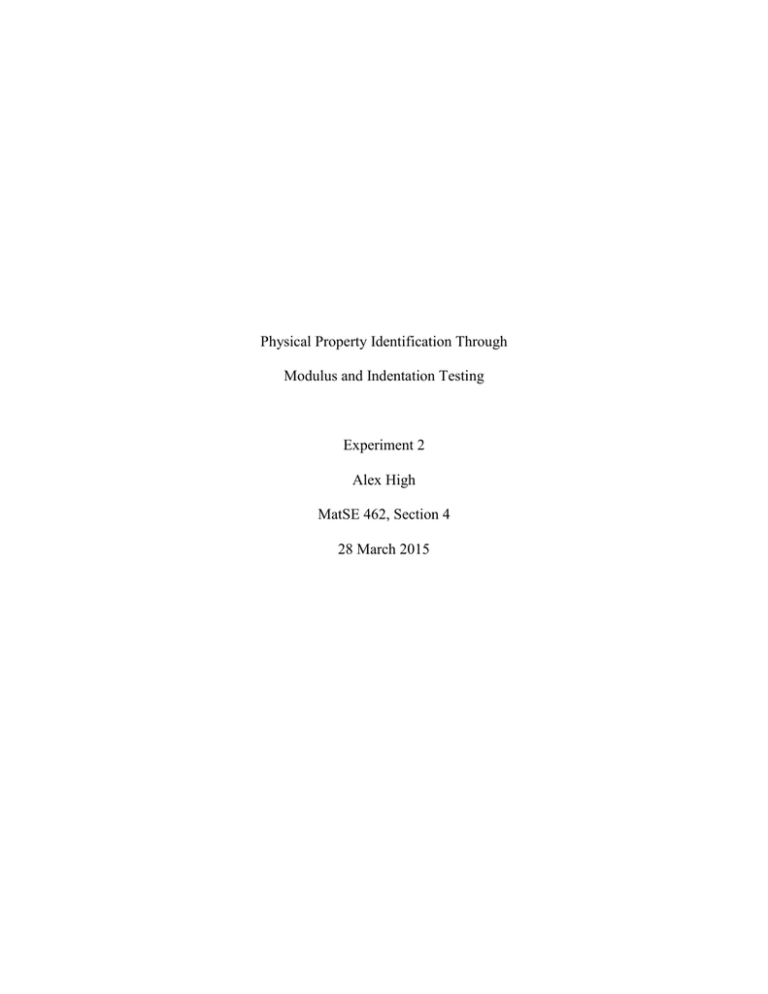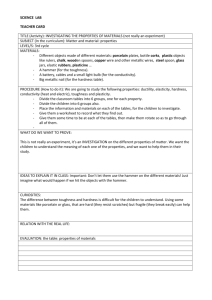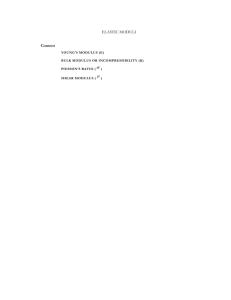Modulus and Indentation Report
advertisement

Physical Property Identification Through Modulus and Indentation Testing Experiment 2 Alex High MatSE 462, Section 4 28 March 2015 Abstract Physical properties are crucial in the selection of materials. Tests that determine and standardize these properties are equally vital. For any material, a value such as the elastic modulus needs to be known. This experiment aimed to identify some of the important physical properties as well as aimed to test the reliability of the testing methods. Overall, the property tests were successful and produced excellent results. Introduction Four experiments were conducted on selected materials, with the intent of identifying various physical properties about these metals. Rockwell Hardness, Vicker’s Indentation, Charpy Impact, and sound velocity testing were the conducted experiments. Through these experiments, values such as hardness, toughness, elastic modulus and Poisson’s ratio were determined. The Rockwell Hardness tests were conducted on metals and on metal alloys, specifically 1340 steel, 1144 steel, 6061 aluminum and 260 brass. The Vicker’s Indentation tests, for hardness and toughness, were conducted on the ceramic Yb:YAG. The sound velocity tests were conducted on zirconia (ZrO2), aluminum, Teflon, and silicon carbide (SiC). The Charpy Impact tests were conducted on 0.2 wt%-carbon steel. Experimental Procedures The four tests were conducted in specific manners. The Rockwell Hardness test was conducted using the following procedure on a LECO RT-240 hardness tester. For 1340 steel, 6061 Al and 260 brass, as well as for most tests with 1144 Steel, the HRB scale was used. The HRB scale utilized a load of 100 kgf along with a tungsten carbide (WC) indenter tip. The HRB scale was implemented because of the softer nature of these metals. However, for two tests conducted on 1144 steel, the HRC scale was used, due to 1144 steel being a harder alloy. HRC utilized a load of 150 kgf with a diamond indenter tip. Once the appropriate scale was selected, the sample, with flat and parallel faces, was placed onto the stage. Care was taken to ensure that the indenter tip was at minimum two indent diameters from existing indents. The stage was turned upwards until the tip came into contact with the sample, at which point the stage clicked into place and the machine ran its test. The Vicker’s Indentation tests were conducted using two machines. A LECO MHT Series 200 was used to determine the toughness of samples while a LECO V-100C1 was used to determine the hardness of samples. The samples were polished goldcoated Yb:YAG. For the toughness measurements on the MHT Series 200, a load of 0.5 kgf was used. For the hardness measurements on the V-100-C1, a 0.3 kgf load was used. Both machines operated very similarly, and both used the ConfiDent software. The actual sample testing was conducted using the following procedure. The sample was placed onto the stage, and the stage was moved, if necessary, to ensure that the future indent, shown on the screen, would be more than three indent diagonals away from existing indents. The mode was then rotated from the microscope to the indenter tip, and the test was started. Once the test had concluded, the mode was rotated back to the microscope objective, which was subsequently refocused, and the “capture” program was selected. For the hardness tests, the four lines were moved to the corners of the indent. For the toughness tests, the four lines were moved to the end of the cracks that had propagated from the corners of the indent. Take care to ensure that the indent is similar to the images in Figure 1. Any other indent figure, with either large cracks or asymmetrical sides, etc. are unacceptable, and the sample must thusly be indented again. Figure 1. – Accepable indent figures. The sound velocity test was conducted to identify the elastic modulus and the Poisson’s ratio of several materials. The samples tested were ZrO2, Al, Teflon and SiC. The tests were conducted using the following procedure. First, the appropriate transducers were selected and screwed on, depending on whether the test was in longitudinal mode or in shear mode. A small drop of coupling fluid was applied to one of the transducer faces, and the faces were rubbed together to spread the fluid over both faces. For the longitudinal mode, Couplant A was applied, and for the shear mode, honey was applied. For any shear mode test, the transducer heads were aligned according to the arrows on the heads. The time scale on the oscilloscope was zeroed by squeezing the transducer heads together. The left vertical cursor line was aligned with the trough/peak of the first valley/peak. The test was then conducted with the sample between transducer heads. The trough/peak shift was marked using the right vertical cursor, and the time difference between left and right cursor was recorded. The Charpy tests were conducted on 0.2 wt%-C steel. The tests were conducted using the following procedure. A notched bar sample, at a known temperature, was placed on the stage, and the pendulum hammer was raised to lock. The test was then conducted, and the values were recorded. The following two types of samples were used in these tests: longitudinal, where the sample lengths were cut parallel to the rolling direction; and transverse, where the sample lengths were cut perpendicular to the rolling direction. Results and Discussion The time difference for the sound velocity was used to calculate the elastic µ modulus and the Poisson’s ratio of the tested materials. Using the equation, 𝑐𝑠 = √𝜌, where cs is the wave speed and ρ is the density, the bulk modulus, µ, can be calculated which in turn allows for the calculation of the Poisson’s ratio, the shear modulus and the elastic modulus for each tested material2. The average calculated elastic modulus and Poisson’s ratio are listed in Table 1. ZrO2 Avg. STD 93.93 4.77 SiC Avg. STD 311.11 36.06 Al Avg. STD 70.25 2.37 Teflon Avg. STD 1.416 0.098 Elastic Modulus (GPa) Poisson’s 0.181 0.059 0.106 0.079 0.328 0.023 0.43 0.023 ratio Table 1. – Average elastic modulus and Poisson’s ratio values for materials tested using sound velocity. Standard values give that ZrO2 has an elastic modulus of 126 GPa, which falls outside of three standard deviations of the calculated elastic modulus. Additionally, the standard Poisson’s ratio is given as 0.185, which within three standard deviations of the calculated 0.181 ratio. The SiC has a standard elastic modulus of 416 GPa, which falls within three standard deviations of the calculated 311.11 GPa value. SiC’s standard Poisson’s ratio of 0.14 is exactly three standard deviations away from the calculated value. For aluminum, the standard value of 70 GPa matches the calculated value exactly, while the Poisson’s ratio is very similar as well. The elastic modulus of Teflon, approximately 9.0 GPa (23°C) is not within three standard deviation values of the calculated value1. However, its Poisson’s ratio of 0.46 (at 23°C) is well within three standard deviations of the calculated value1. There is an obvious source of error in these calculations, and that arises from the subjectivity of the test. The velocity reading relies heavily on how tightly the transducers were held on either side of the sample. This variability has great potential in skewing results. The Rockwell Hardness value standards were all within three standard deviations of the calculated values (Table 2). This test was extremely mechanized and had little room for human error3. 1340 Steel 1144 Steel 6061 Al 260 Brass Avg. STD Avg. STD Avg. STD Avg. STD HRB 99.9 0.94 77.5 1.81 58.3 5.78 HRC 53.7 2.05 22.7 0.21 Table 2. – Average Rockwell Hardness values for selected metals and metal alloys. The Vicker’s tests (Table 4, 5) were similar in mechanization to the Rockwell tests, and again, the calculated values all were similar to the standard values3. Yb:YAG Yb:YAG Class Avg. STD Avg. STD HV 513 15.21 512.5385 19.57 Table 3. – Average Vicker’s Indentation Hardness values for Yb:YAG. Yb:YAG Avg. STD Yb:YAG Class 1 Avg. STD Yb:YAG Class 2 Avg. STD KIC 115 14.52 87.70 11.08 87.57 10.41 Table 4. – Average Vicker’s Indentation Toughness values for Yb:YAG. The Charpy Impact test provided data, which was plotted in Chart 1. Since each sample was tested at a specific temperature, this data could be plotted versus energy absorbed (in ft-lbs) to assist in the identification of the ductile-to-brittle transition temperature. These values will be different for the transverse and the longitudinal samples due to the possible failure directions based on slip mechanisms. These temperatures are demarcated by the vertical black lines in the graph. For the longitudinal sample, the ductile-to-brittle transition temperature is -50°C. For the transverse sample, the ductile-to-brittle transition temperature is -37°C. Chapy Impact Toughness Transverse 90 80 Longitudinal 70 CVN (f-lbs) 60 50 40 30 20 10 Temperature (°C) 0 -80 -60 -40 -20 0 20 40 Chart 1. – Charpy Impact Toughness with ductile-to-brittle transition temperature. Conclusion Ultimately, the property tests were extremely successful. The tests were consistent in providing the appropriate values. The only real error, or possible source of error, in testing occurred in the sound velocity tests, where results were affected by how tightly the transducer heads were applied to the sample. This resulted in skewed results for materials such as ZrO2. However, the hardness and toughness tests provided excellent data, making the overall experiment successful. Citations 1. Teflon PTFE, DuPont. 3/27/15. < http://www.rjchase.com/ptfe_handbook.pdf> 2. Standard Practice for Measuring Ultrasonic Velocity in Materials, ASTM International. https://cms.psu.edu/Merge/2009/MRG-150103-132958ERB105/_assoc/1D6B8A3A76B544A183E5410A414DB396/ASTM_Standar d_E494-10_Ultrasonic_Velocit.pdf 3. Standard Hardness Conversion Tables, ASTM International. <https://cms.psu.edu/Merge/2009/MRG-150103-132958ERB105/_assoc/A73AE97AF1354C9ABEA2F0C5247D17CC/ASTM_Standa rd_E140-12b_Std_Hardness_Conv.pdf>




